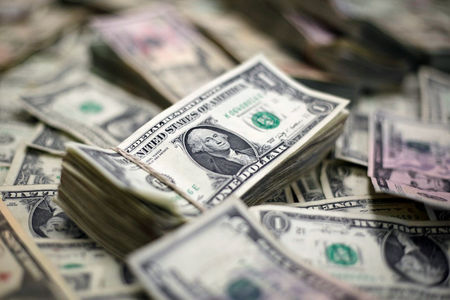Forex
Dollar stable after payrolls gains; euro slips on weak data

Investing.com – The U.S. dollar stabilized Monday, holding onto the gains seen after Friday’s strong jobs report at the start of a week that includes the release of key inflation data as well as the minutes from the last Federal Reserve meeting.
At 04:00 ET (08:00 GMT), the Dollar Index, which tracks the greenback against a basket of six other currencies, traded marginally lower at 102.247. It rose 0.5% on Friday to a seven-week high, logging more than 2% gains for the week, its biggest in two years.
Payrolls boosts the dollar
The growth in US quashed fears of a U.S. economic slowdown, and furthered the notion that the Fed will not need to cut interest rates sharply to support the economy, boosting the dollar.
Traders were seen largely wiping out bets on another 50 basis point cut at the next Fed meeting, and were pricing in an over 90% chance of a 25 bps cut, CME Fedwatch showed.
Focus this week is on addresses by a slew of Fed officials, more inflation data, as well as the minutes of the Fed’s September meeting. The Fed had cut rates by 50 bps during the meeting and announced the start of an easing cycle, although it still said future rate cuts will be data-dependent.
“The blowout US jobs report on Friday prompted the kind of hawkish repricing in rate expectations we thought would have materialised over a few weeks,” said analysts at ING, in a note.
“Markets no longer have pretext to look through Federal Reserve Chair Jerome Powell’s pushback against 50bp cuts, and are now finally aligned with the Dot Plot projections: 25bp cuts in November and December.”
The safe-haven greenback has also received a boost from the turmoil in the Middle East, with Israel bombing Hezbollah targets in Lebanon and the Gaza Strip on Sunday ahead of Monday’s one-year anniversary of the Oct. 7 attacks that sparked its war.
Weak German data hits euro
In Europe, drifted 0.1% lower to 1.0965, with the euro weakening after slumped 5.8% on the month in August, another illustration of the economic difficulties the eurozone’s largest economy is struggling with.
for August are due later in the session, and should show how consumers are faring during these tricky times.
ECB chief economist Philip Lane as well as board members Piero Cipollone and Jose Luis Escriva are all scheduled to speak later Monday, and are likely to follow President Christine Lagarde in signalling a brisk pace of further easing.
slipped slightly to 1.3113, after suffering a 1.9% drop last week, its steepest fall since early 2023.
Bank of England Chief Economist Huw Pill said on Friday the central bank should move only gradually with cutting interest rates, a day after governor Andrew Bailey was quoted as saying the BoE might move more aggressively to lower borrowing costs.
Doubts over BoJ raising rates
fell 0.3% to 148.22, paring back earlier gains after the pair surged to its highest level since mid-August.
The yen was hit by growing doubts over the Bank of Japan’s ability to keep raising interest rates in the coming months, especially amid uncertainty over the upcoming Japanese general elections.
was largely unchanged at 7.0176, with Chinese markets still closed as the country celebrates Golden Week.

 Forex3 years ago
Forex3 years agoForex Today: the dollar is gaining strength amid gloomy sentiment at the start of the Fed’s week

 Forex3 years ago
Forex3 years agoUnbiased review of Pocket Option broker

 Forex3 years ago
Forex3 years agoDollar to pound sterling exchange rate today: Pound plummeted to its lowest since 1985

 Forex3 years ago
Forex3 years agoHow is the Australian dollar doing today?

 Cryptocurrency3 years ago
Cryptocurrency3 years agoWhat happened in the crypto market – current events today

 World3 years ago
World3 years agoWhy are modern video games an art form?

 Commodities3 years ago
Commodities3 years agoCopper continues to fall in price on expectations of lower demand in China

 Economy3 years ago
Economy3 years agoCrude oil tankers double in price due to EU anti-Russian sanctions





















